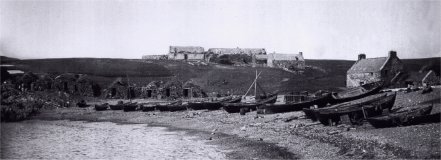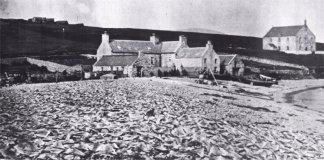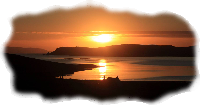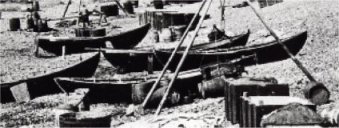

From about 1415, pioneering fish merchants from the north of Germany, who until then had bought Shetland fish in Norway, decided to bypass Norway and sail direct to Shetland to buy fish.
This Hanseatic trade became an important part of Northmavine's economy for years to come.
Salt was crucial for curing whitefish, and when duty was demanded on imported salt, this pretty much ruined the foreign fish traders business' and would have destroyed the local economy had it not been for the local landlords who saw an opening and by the 1730's they were exporting dried salted fish to the Mediterranean countries themselves.
The need for more Haaf fishermen steadily grew and to meet demand, some devious landlords divided the crofts into smaller and smaller inadequate units, so if the men were to provide food and shelter for their families, they had to go to the fishing. To add insult to injury the boats and lines used were often hired from the landlord, and fishermen were compelled sell any fish caught to the local merchant at a rock bottom price, set by him. As the landlords usually owned the shops, people were given credit notes, ensuring they could only buy their goods from him, so increasing his profits. This was known as the Truck system and it was wide spread within Shetland.
The boat used by haaf fishermen was the sixern; this boat had six-oars. They were clinker built open boats that handled well in rough conditions. The crew usually rowed the sixerns even though some fishing grounds were 40 miles from land - hence named the Far Haaf.
The sixerns around the first of the 1800's measured only 20 to 24 feet, with a beam of 6 to 7 feet, but by the 19th century they were 30 to 36 feet long.
Onboard every thing had its place and the sixern was divided into six 'rooms' or spaces, called the forehead, fore-room, mid-room, owsin room, shot-room and the horek or kani where the skipper worked the helm, navigating with help from the sun, stars and da moder dy - a sea swell used to aid navigation. Ronas Hill was also used as a meid - a meid is a landmark, still used by Shetland fishermen to find a position at sea. Amidships, was where the fishing lines were set and then hauled. The shot-room was the biggest room and used for ballast and as the fish hold. In the fore section of the sixern the 'necessaries' or provisions for the trip were stored along with peats and a fire-kettle.
Hillswick was a trading harbour offering good anchorage and shelter for sailing ships, the beach was also perfect for landing and curing salt fish. The Booth have records dating back to 1698 when Daniel, son of Adolf Westermann, a Hanseatic merchant from Hamburg in Germany registered the building as a böd, or trading post from where goods including Shetland knitwear and butter as well as cured fish were traded to the Hanseatic fleet.
The local folk who could afford them, obtained timber from Norway, tea, tobacco and gin, as well as some luxury goods like lace from Europe.

Fish such as saithe and cod were caught on lines. In Eshaness the long lines were made with several 40 to 50 fathom lengths of bowts, with the fish hooks a regular 1 fathom apart. In some districts the long lines were called baukts and the hooks were spaced 3 to 5 fathoms along the lines and attached by three to four feet long snoods or 'toms'. The bowts or baukts were tied together as they were set and could be a much as six or seven miles in length. Stone sinkers were fixed with ropes to marker buoys to hold the lines in place until they were hauled. The bowts or long lines were treated in cootch to prolong their life. This was done in cootch kettles and a fine example can be seen at Hillswick. HEARD is proud to say this is one of the restoration projects undertaken by the group.
The catches were landed at haaf stations, a fine old haaf fishing station and lodge, although in ruins, can be seen at Stenness in Eshaness.
Curing the fish was done mostly by boys and older men and got underway immediately the boats came in. Saithe, cod or tusk were split, then boned and thoroughly washed before being layered with salt in large wooden tubs and left for about five days, after which they were rewashed and then piled on the beach to drain. The fish were then spread out across the beach to dry; the flesh side was laid uppermost to dry first. Each night they were stacked into piles or staples and finally, when dried or pined, the fish shrank and salt appeared on the surface, this was called bloom, they were then loaded onto the ship and Russian mats, made from the bark of linden, was used as dunnage, and was laid under, among and over the dried fish to stop them from getting wet, only then was the fish deemed ready for the long sea trip ahead of them.
The sixerns were based at haaf stations close to the fishing grounds and built on stony beaches or ayres, this was usually the only place possible to land and haul up a boat along the exposed coastline as the picture on the right shows of Sixerns on the Stenness beach.

